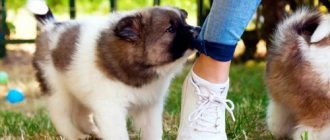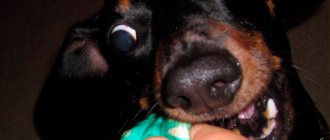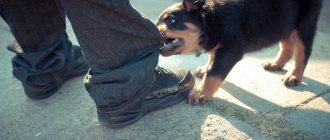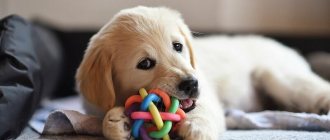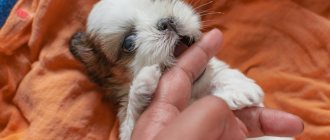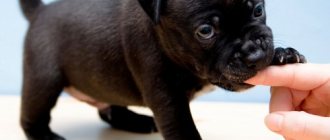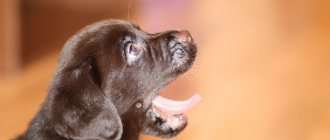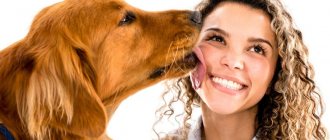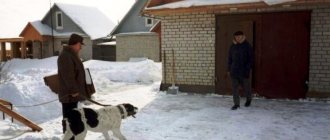For predators, which include dogs, biting is quite natural. This is how they express their emotions and react to stimuli. But if your pet’s behavior is not corrected in time, it can subsequently cause serious injury. The reasons for a dog's unacceptable behavior may be lack of training or instinctive reactions. It is important to teach from an early age
puppycontrol yourself so that it is manageable and does not pose a danger to others.
Why does a puppy bite its owner?
A dog is a devoted friend to man, but also a social animal, which is characterized by the instincts of its ancestors. They are genetically programmed to use their teeth in the struggle for leadership and survival.
If you raise the animal correctly, the dog will not bite people. However, there are certain reasons that contribute to the manifestation of aggression and uncontrolled behavior of a pet:
- Owners beat dogs in an attempt to gain obedience (such animals pose a threat to others);
- The dog’s desire to take possession of food, position;
- Serious illness of the pet;
- Nervous disorders;
- Jealousy;
- Fear is a product of cowardice and self-doubt.
The reasons for an animal’s bad behavior can have both a physiological and psychological basis.
On a note! Certain breeds of dogs are more prone to aggressive behavior than others. In this case, you cannot do without professional training and education.
In each case, the pet uses its teeth to protect itself from the problem. Only a professional will be able to understand the pet’s condition and take the right steps towards correcting the puppy’s antisocial behavior.
Defensive aggression
It may be the influence of heredity, as well as an environmental factor. When purchasing a puppy, always look at the sire and dam before choosing one of their offspring. The reason is the strong influence of heredity on possible behavior.
If the parents are angry, there is a good chance that the puppy will be angry when he grows up. Behavior as such is not inherited, but predisposition is important. The puppy does not inherit anger from its parent, but it may inherit the tendency to react that way to a situation.
We all know that dogs are territorial by nature. For thousands of years, their survival depended on protecting their domains.
They will fight to protect themselves, food, or when they feel threatened. As predators, the animals have a long history of hunting and killing prey. Many of these reflexes still live in them.
If they are not stopped at the very beginning, the pet will develop a defensive attitude towards food or food aggression, threatening anyone who approaches the food, growling or biting.
Such types of behavior are natural in natural conditions. No one wants to have a four-legged friend from whom you don't know what to expect. These problems need to be addressed properly.
How to stop a puppy from biting
A puppy under 4 months of age, due to the presence of milk teeth, cannot control the force of its bite, and therefore during play may painfully bite the owner’s arms or legs. It is important that this innocent habit does not enter adult life.
Puppies cannot calculate their bite force until their baby teeth are replaced by molars.
What to do:
- At the first stage of training, you shouldn’t panic and make a tragedy happen because of a bite, much less scold or scold your pet;
- If the puppy bit you intentionally, then you should use the “fu” command, creating a light slap with your palm in the croup area (the animal cannot be hit on other parts of the body);
- If an accidental bite occurs, for example, during play, you need to stop the activity, wait 10 seconds until the animal calms down, and then continue playing;
If your puppy starts biting during play, you need to pause.
- If biting has become a habit, you need to work thoroughly with your pet in order to avoid serious consequences in the future.
Attention! When raising an animal, it is important to take into account the fact that the pet must be at the level of the hierarchy after all family members; this is the only way to rationally manage it.
Trainers have developed a lot of ways to wean a dog from biting, the main thing is to use commands correctly and get the puppy to strictly follow them. It is important to praise your pet and reward it with its favorite treat.
Moderate use of rewards will motivate your puppy to change behavior.
Video - Weaning a puppy from biting
Preventive measures
To avoid having to wean the dog off biting in the future, you need to immediately put the animal in its place and apply preventive measures. Here are some of them:
- Do not allow your four-legged dog to sleep on your bed. The dog must sleep in the place allocated to him, which is located below the bed of the “pack leader”.
- Never let the tailed one go out and enter the apartment first, or walk up the stairs ahead of you. The “leader” should go first.
- If you are walking on the street and the path you are walking on with your pet is too narrow, do not give way to the dog. Walk along it yourself; your pet can walk along the side of the road.
- Try to eat your own food before feeding your dog.
- Prepare and serve food to your dog so that he can see that the food is not coming from nowhere. The dog must see that what he receives is given to him by the owner.
- If you command your pet any command, be sure to wait for the four-legged dog to execute it, even if it takes a long time.
Raising a puppy while playing
It is necessary to wean a dog from biting its owner, animals and strangers at an early age, before teeth change. Since puppies do not yet know how to determine the boundaries between playful behavior and aggression, they may attempt to bite their owner without malicious intent. It is important to let your pet know that exposing its fangs is unacceptable. It is recommended to stop a puppy that is playing too much in the following ways:
- If you notice that the puppy wants to bite, hide your hands behind your back, and when he closes his mouth and does not perform the desired action, praise your pet and give him something tasty;
- During play, you need to make sure that the puppy bites not the hands or feet of the owner, but the toy;
It is important not to give your puppy access to parts of your body, redirecting his activity to other objects
These play forms are suitable for puppies up to 4 months. Afterwards you need to move on to full training and physical punishment. It is important to remember that you cannot show unreasonable aggression towards your pet, destroying the animal’s psyche. Punishments should be understandable to the dog and serve as a lesson to him, and not be a way to discharge his owner.
Outside of play, continue to teach your pet self-control. While at rest, place your fist on your pet’s muzzle; if he bites him, say “no” or “fu-fu”; if not, then click your fingers and reward the dog with a treat. You need to repeat such actions often, several times a day, until the instincts are fixed.
At what age should you start?
It is recommended to begin systematic training when the Jack Russell Terrier puppy is two months old.
But by this time he should already know some of the basic commands, since the puppy begins to teach them from the first day of his appearance in the house.
How to stop an adult dog from biting
Advice from experienced dog breeders:
- If a violent mood appears, take the pet by the withers and pat it, while using the commands “fu-fu”, stop or not;
Touching the withers will not be perceived painfully by the puppy, but will indicate the boundaries of its permissibility.
- After this, you can continue training - fixing obedience commands, for example, place or sit;
- After each skillful action, praise your pet and give him something tasty;
- You can press the dog to the ground to calm its ardor. It is not recommended to perform such actions with large breed dogs;
- If the dog is small, then you can hold it by the muzzle, immobilizing the jaws (while controlling the pet’s breathing);
Holding large dogs by the jaw is not recommended.
- When playing with your dog, you can turn him over on his back and stroke his belly. It is best if she herself gives the opportunity to rub her on the “soft areas”, recognizing the status of the owner.
Such exercises should be performed alternately, the main thing is that the pet does not feel aggression on your part, but only affection, attention and care. It is equally important to earn and maintain the dog’s respect, then it will freely obey you, respect and obey your household members.
Learn to bite correctly
In fact, from birth a dog does not know how to bite correctly, and only with the help of the skillful actions of a specialist can the animal’s instincts be corrected. If necessary, it is necessary to stimulate the actions of “biting” as early as possible.
However, you should not train your dog to grab the owner’s clothes or special suit. It is also forbidden to look your pet in the eyes, which will involuntarily allow him to retreat. By averting your eyes, you provoke aggression in the animal, like prey trying to escape.
A huge role in building relationships with a puppy is given to the emotional reactions of the owner.
Attention! As soon as the dog grabs the rag (roller, cuff), you need to tease the pet for a few seconds, and then release the bait and reward the pet with delicious food.
Over time, increase the size of the roller, holding it both vertically and horizontally, honing the actions of the animal. It is important to practice grip stability, and threats should be sharp and loud, without force on the pet.
When raising a pet, the owner must show confidence, which will soon be transferred to the puppy.
Correct actions by the trainer will give the dog confidence and make its behavior controlled. Such a dog will not show unbridled aggression towards others, unlike a cowardly animal.
Errors and prohibited measures
Under no circumstances should you achieve your goals by beating, hysterical screaming and loud swearing. Such behavior can cause aggression in the animal, including attacks and bites, and at the same time completely discourage learning. In addition, such an approach reduces the authority of the owner in the eyes of the animal.
The main mistake of the trainer is incorrect behavior, which is why the development of the necessary skills is inhibited, and undesirable skills, on the contrary, are learned very well.
Common mistakes owners make when rehabilitating bites are:
- Ignorance that the dog is capable of specifically understanding human speech. The trainer changes commands, and for each command the dog develops new skills. If the command sounds like “Sit,” then next time you cannot say “Sit down,” “Sit down,” etc. For the animal, each new command sounds like a completely different sound stimulus.
- When correcting behavior, you cannot respond with any emotions to the animal’s excitement. Even affection and encouragement can harm the process. All reactions must be thoughtful and calm.
- It is forbidden to punish a dog for biting with a walk and food. All basic needs must be satisfied (even if the dog does not obey at all), since his health in the future depends on this.
A rough attitude causes fear in the animal and can lead to increased aggression, development of nervousness and anxiety.
Training a four-legged pet requires the necessary skills and knowledge. And if you are not confident in your own abilities, it is better to entrust dog training to a professional dog handler. He will develop an effective training methodology for a specific breed and help consolidate the acquired knowledge in practice. After completing the classes, you are guaranteed to get the required result, that is, an obedient and friendly dog.
Tactics for dealing with an adult pet
If a puppy can be weaned from biting in a few months, then with an adult dog the situation is more serious.
On a note! If the dog has not bitten before, and suddenly starts doing this, reconsider your approach to the pet, perhaps you have become ruder, a new family member has appeared, towards whom the dog does not have friendly feelings. Maybe someone offended the dog, because aggression is a response to physical punishment.
The reason for a puppy’s aggression can also be inhumane treatment of him, calling for protest
How to fix the situation:
- When communicating with your pet, do not use games that can exacerbate the desire to “bite”;
- Physical punishment should not be used; this method of education will increase the degree of aggressiveness of the animal;
- If a pet is loyal to its owner, it will not cause him pain, because the animal is capable of understanding and experiencing human emotions;
If a pet trusts its owner, it will not want to hurt him
- A dog can bite an owner if it does not recognize him as a leader, much less dominates him. Often such situations happen to a child when the dog perceives him as a brother. In this case, serious training will be required, during which the concepts of who is who are identified.
The dog is forced to recognize the superiority of the owner, however, one cannot go too far - not giving food, toys or depriving him of a walk. All actions must be tolerant and careful.
Help from a dog handler
If you have not been able to correct the behavior on your own before the age of 6 months, contact a dog trainer. Both individual and group lessons are useful. Among them:
- ordinary classes:
the dog handler will select the right technique, correct errors in education, and correct actions; - general training course (GTC):
will help develop obedience, acquire normal dog communication skills with other animals and people, and master basic commands; - protective guard service (PSC) course:
suitable for juniors older than 8 months of service and guard breeds, during which dogs will be taught to direct aggression in the right direction, taught to wean themselves from biting without reason, and shown that teeth should only be used at the command of the owner.
Pet training methods
There are some myths about raising a pet, what you can do and what you can’t do when trying to wean a dog from biting its owner or damaging the household’s things.
Table 1. Parenting methods and their consequences
| Wrong methods | Correct Methods |
| Let the situation take its course, they say - he will outgrow it, and with age he will understand that this cannot be done | If the puppy grabs your hand during play, then make a sharp, piercing exclamation “aarp”, which will allow the pet to recoil from the “prey” |
| Hitting the dog, which will lead to hidden anger, which over time can develop into uncontrollable aggression | Switch your attention to a toy that does not make sounds, which means it will be an excellent way to play with your puppy |
| Stop playing with the puppy altogether, reducing the risk of being bitten. The method is considered incorrect, since it is important not to avoid the problem, but to solve it | If the puppy bites, stop playing, leave the area and ignore the animal for 15 minutes, and then return to play. If necessary, repeat the steps |
Thus, the desire to bite will disappear. Improvement in your pet's behavior will be noticeable from the first lessons. The main thing is to use only humane ways to correct a disobedient puppy.
The child should be familiar with basic commands and be able to use them when communicating with the puppy
Teach children to use the command “shut your mouth”, “fu”, “no” so that they can take the right actions in time. Reward your pet every time the command is performed correctly.
Are they trainable?
By nature, Jack Russells are very intelligent and quick-witted. Training them is not difficult if, when training a dog, you take into account its breed characteristics.
One of the main problems that arise when training Jack Russells is their irrepressible activity, due to which the dog is constantly distracted and cannot normally perceive the trainer’s commands..
In order for your pet to be attentive and focused during classes, it is very important to interest him in the learning process itself. For example, stimulating good work with a game or treat.
